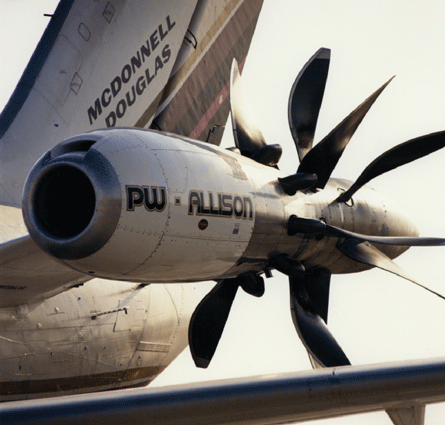Pratt & Whitney has begun studies of open rotor engine architecture despite its long-standing pursuit of geared turbofan (GTF) technology, and does not rule out shifting to a propfan configuration if this path is favoured by the airframers.
The company is developing a GTF engine to power the next generation of regional and single-aisle aircraft. This engine's low-pressure spool operates at high speeds for peak efficiency, while its fan operates at slower speeds to maximise efficiency and significantly reduce noise.
| |
|---|
A demonstrator "578-DX" open-rotor engine was tested in the 1980s |
P&W next generation product family vice-president Robert Saia says the GTF engine will undergo noise, performance and endurance testing in December, when it is run in a Florida test cell.
This will be followed by on-wing trials, using a Boeing 747 testbed, which are scheduled to run for around five months from next June.
Other engine manufacturers are working on unducted fan (UDF), or propfan, technology. Saia says the GTF design will deliver 90% of the UDF's fuel efficiency without the cabin and environmental noise penalty, enabling it to avoid costly noise abatement routes.
He adds the rival products would require a new high-wing or rear-engined design, which will increase airframe development time compared with the conventionally mounted GTF.
But, despite these reservations, the manufacturer is considering coupling its geared technology with an open rotor design as a future project, as the manufacturers begin to put forward potential airframe and engine configurations.
An open rotor design would need to be roughly twice the diameter of its 1.83m (6ft) GTF equivalent, causing weight, noise and aerodynamic drag penalties.
P&W undertook joint studies of this technology in the 1980s with Allison, and a demonstrator "578-DX" engine flew on a McDonnell Douglas MD-80 flying testbed in April 1989.
"We are at the beginning of studying an open rotor," Saia says. "It is really the next generation. The question is when is it? Is it 2017, like our competitor is saying, or is it 2020 or 2022? And does it create a different aircraft design than what we see today?
"That is something we have to work with the aircraft manufacturers [on]. If the aircraft manufacturers go that way, then certainly we'd be prepared to go that way, still leveraging all the technology that we're working on now," says Saia.
"It would be a geared type. It would be a different gear, but the basic fundamental design and technology of that gear system would be fundamentally the same."
Related blog
Related stories
- P&W prepares for geared fan launch
- Green sky thinking - carbon credits and the propfan comeback?
- For more news, pictures and information about the Boeing 747 please visit our 747 page
Flight turboprops special
Turboprops bounce back
Source: FlightGlobal.com

















